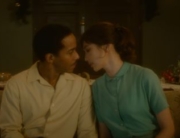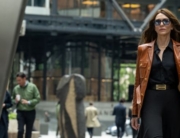Postcards from London is writer-director Steve McLean’s first film since 1994’s Postcards from America. It stars Harris Dickinson (Beach Rats) as Jim, a young British gay man from the suburbs who, in lieu of college, has gone off to the big city for his education. After all his money is stolen nearly the instant he arrives in London, Jim goes to a seedy alleyway bar in Soho in search of a job. The bartender promptly directs him over to the corner booth, where he meets a team of male escorts known as the Raconteurs. Not your average rent boy outfit, the Raconteurs elevate the sex worker experience by offering their upper-class clientele pre- and postcoital intellectual conversation. By intensely studying art history, each of the Raconteurs becomes an expert on all things art history so they can keep their particular clientele coming back for more.
When Jim goes to his first john’s house, the man shows him a baroque painting he owns, and Jim faints from the sight of its beauty. As this keeps happening to him, the Raconteurs come to his aid and send him to a doctor who specializes in rare psychiatric disorders. As it turns out, because of a past relationship with his high school art teacher, who seduced him by showing him works of art, Jim now suffers from a rare disorder known as Stendhal syndrome—he faints and experiences hallucinations whenever he comes face-to-face with captivating art.
What the Stendhal syndrome motif sets up (brilliantly, quite honestly) is a discussion of what is true art. Do Jim’s fainting spells happen only when he sees work that he personally finds compelling, or is the judgment of art’s purity cast on the creators behind the work? In other words, is art better when the artist suffers? And if so, is it the suffering that Jim picks up on? If that is the case, then he is reacting to the connection between himself and the artist. This is why when he is passes out, he envisions himself, his fellow Raconteurs, and his johns posing for the paintings.
Postcards from London is set entirely on a soundstage, à la Lars von Trier’s Dogville and Manderlay. Whereas von Trier’s films drew attention to their stage settings, in Postcards, a bar looks like a bar, an alleyway looks like an alleyway, a bedroom a bedroom. Background sounds, such as dogs barking and police sirens, make the scenes feel like they are really taking place in a city. It’s only the absence of natural light that makes it apparent that we are on a soundstage.
Fans of Dickinson, the star of last year’s Beach Rats (which totally got overshadowed by Call Me by Your Name), will enjoy his turn as Jim, this time playing an openly gay man. The camera loves Dickinson, but the camera also loves his fellow Raconteurs (Jonah Hauer-King, Alessandro Cimadamore, Leonardo Salerni, and Raphael Desprez), so much so it’s disappointing that it didn’t spend more time getting to know them. The film even seems to be setting one of them up as a love interest for Jim, only to abandon the idea about halfway through. By my count, Jim has three love interests, none of whom go anywhere, so maybe that’s McLean’s opinion on monogamy.
There is some meta-commentary going on: the characters all wear fashion from different time periods, representing different times in which Soho was en vogue. Postcards from London, too, seems to belong to a different time, back when indie gay films were more experimental, more edgy, and therefore more fun than they are now.

















Leave A Comment